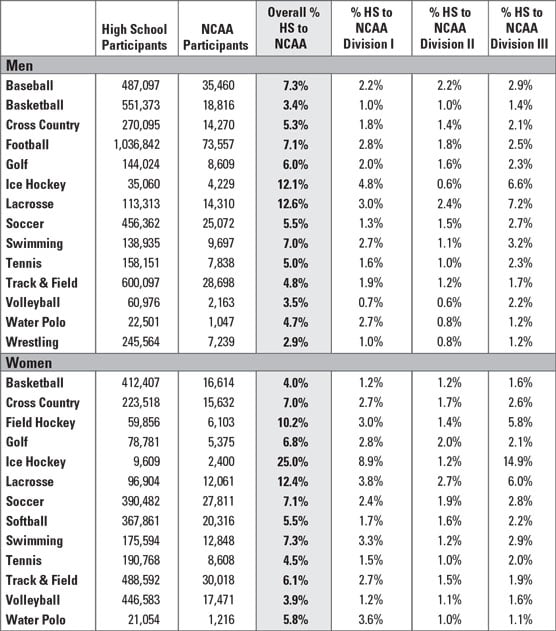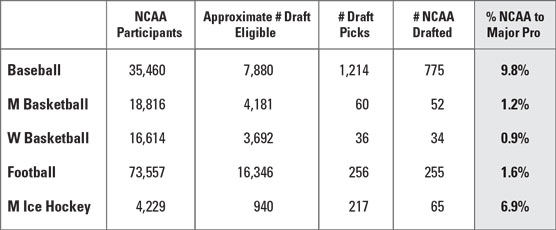Parents and their kids have all kinds of dreams and fantasies about their kids playing sports, getting scholarships, maybe turning them into professionals and making big money from their sport. There is nothing inherently wrong with having dreams and aspirations, but it is important to be very grounded in reality and to be tempered with strong back-up plans.
This article discusses some numbers that show the prevalence of different types of athletes at the college level and the reality surrounding sports scholarships and being a recruited student athlete.
Few people are fortunate enough to possess the talent, drive, and luck that is often required to earn decent money from playing sports. And even if it does happen years later, I can guarantee you that the period of earning money will not last long, and that your son or daughter will still have many more years of working adult life.
Try to stay focused on the long-term benefits that exercise can provide, including:
- Fitness and Wellness: This can also include understanding the value of good nutrition and not putting bad things (drugs, alcohol, etc.) into your body because of how you feel and the damage they can do.
- Understand the value of effort and focus: To master and excel in sports, a student-athlete must put in a good deal of practice. Of course, this should be done in moderation and not infringe on having enough time to do well in school.
- Experience the value of teamwork and playing a role: I think this is one of the greatest benefits of playing sports, especially team sports. Think about it – when your son or daughter joins the workforce, these teamwork skills will come into play and come in handy.
- Mastering time management and juggling different responsibilities: You can’t take difficult courses and have as much external commitment as a college sport if you’re not good at managing your time. To that I would also add that it is an activity to keep teens out of trouble. It spends free time and tires the participants!
Probability of competing in college athletics
The NCAA has compiled some useful statistics that show the portion of high school athletes who go on to make college-level teams for various men’s and women’s sports. The data also shows how team sporting opportunities erupt through division of play.
Overall, the NCAA calculates that there are approximately 8 million high school athletes, and of those, about 480,000 (or 6 percent) continue to compete at the college level. Please keep in mind as you review the data in the figure below that just because someone makes a college team doesn’t mean they get a lot of time – if any – in play or even a place on a roster in a team that spans more than four years.

Percentage of high school athletes who continue to play at the college level.
The likelihood of competing in professional sports
Another reason that some are attracted to sports and college athletics is the hope or dream of making it professionally. This is, of course, limited to a handful of sports. The following figure shows what portion of eligible collegiate athletes are drafted in a given year.
Please keep in mind that getting drafted doesn’t in any way mean that these athletes are able to make a good living for any length of time on the pro circuit. The vast majority of drafted athletes never make it to the “Big Show” or equivalent and end up moving on to something else after one or a few years in the minor leagues (at low pay) for their chosen sport.

Percentage of collegiate athletes who subsequently play professional sports.
How do college sports scholarships work?
There are a lot of misconceptions and misunderstandings regarding team sports awarding. And there is a great opportunity to take advantage of it and end up without good college options for those seeking to enlist as a student-athlete, whether or not a scholarship is included. Being an educated customer is the key to making sound decisions.
Full Scholarships vs Partial Scholarships
The vast majority of sports scholarships (99 percent in fact) are partial scholarships and are for so-called equivalence sports. Division I men’s equivalent sports are baseball, cross country, fencing, golf, gymnastics, ice hockey, lacrosse, rifle, skiing, soccer, swimming, tennis, track and field, volleyball, water polo, and wrestling. For the women in Division I, the valence sports are bowling, cross-country, fencing, hockey, golf, ice hockey, lacrosse, rowing, skiing, track and field, soccer, softball, swimming, and water polo.
In addition, all DII sports and NAIA sports are equivalent sports. NAIA is a competitor to the NCAA and is primarily made up of smaller colleges. (The NCAA Division III Sports do not offer sports scholarships.)
Some Full Scholarships for Athletic Equivalents are awarded to the most sought-after and highly regarded recruits. This is more likely to happen to athletes who have offers from multiple colleges to consider and/or who can play a higher division. Some student-athletes choose to play in a lower section for better team/academic fit or because of the lower cost of attendance.
In contrast to equivalence sports, there are so-called number-people sports, and scholarships from these teams are almost always full scholarships (in other words, 100 percent). Only one percent of all undergraduate student athletes have full scholarships. With men’s sports, these teams can include DI basketball and DI-A football (now known as Football Bowl Subdivision). For women’s sports, full head count scholarships come from basketball, gymnastics, tennis and volleyball.
As you might imagine, this is the biggest name for college sports you’ve probably heard of that fits the bill here. These include the following collegiate athletic conferences: American Athletic Conference, Atlantic Coast Conference, Big 12 Conference, Big Ten Conference, Conference USA, Division I FBS Independent, Mid-America Conference, Mountain West Conference, Pac-12 Conference, Southeastern Conference, and Sunbelt Conference.
Dealing with offers of sports recruiters
Most recruited athletes do not receive sports scholarships. Being a “recruiter” means that the following usually happens. College coaches try to identify promising high school student athletes during their high school years. When they find a good fit (including academically) for their program, they may make an offer or extend an invitation to that student-athlete to visit the campus and program.
Most instructors in most programs are given a certain number of placement periods by the Office of Admissions. What this usually means is that with the support of the coach, most of these particular student-athletes are accepted, usually during the early action/decision making period. Instructors, in conjunction with the Office of Admissions, will conduct an initial screening of potential recruits early in the process to ensure that the student-athlete meets the academic and other requirements important to college.
While a student-athlete can get multiple offers from different schools, he needs to choose only one school he sticks to and apply early. This would likely put the student-athlete at a disadvantage because if the coach changed his mind, did not provide enthusiastic support in the admissions process, or the admissions office chose not to accept the student, the student-athlete would likely have lost the other athlete recruited into other institutions. Coaches can’t wait and will pass on to other candidates when it’s clear they aren’t an athlete’s first choice.
Do your homework and make sure you understand what the offer and support of a specific coach for your student-athlete and the prospect of getting an offer of acceptance means. Ask around for the coach’s and school’s track record of past hiring initiatives. In some colleges, nearly all student-athletes who are offered coach support may be accepted, while at others, half or less may eventually succeed.
Of course, your student-athlete should do some soul-searching and make sure that the college you seek to apply to early on as a recruited-athlete is really the one you desire. Good question to think about: If your child has been unable to play at some point due to an injury, a coach cuts a player, or a player becomes disillusioned and chooses to leave a team, how will the student feel about it? In that college without playing her chosen sport?
The worst that can happen, in my observation and opinion, is that stalking after a team sport can distort the college application and selection process for some student-athletes. It’s all about priorities and focus. Finding the right academic schools should take precedence over finding a specific athletic program. A good student-athlete should be able to do both.
At a small talk event for talented high school baseball players wanting to learn more about playing baseball in college, MLB manager and player Joe Girardi advised student-athletes to get the best education possible and told the players that they would be found if they had a talent for playing outside of college. In his own case, he turned down an offer of baseball from a small school with poor academics in the South and ended up getting an engineering degree, playing baseball at Northwestern and being drafted into the MLB.
Ensure that the student fully understands what they are signing up for when it comes to a college sport. Some coaches put sports before academics and everything else. Be sure to explore alternatives, including playing in a lower division where you may get a better financial aid offer or have more time to pursue academics or other interests. With baseball, for example, a lot of bowlers are recruited from playing Division Three and end up playing Major League Baseball.
Club sports are worth considering in some schools and can be very good, especially in larger or larger sports schools. Finally, do not rule out the possibility of your son or daughter entering a school that suits them well and then trying (walking) to do the sport they desire.
Sports Scholarships Offer Facts
When there is a scholarship, make sure you understand the process. The first step is usually for the coach to extend what is called a verbal grant offer. As you might imagine, an oral offer is not a legally binding offer for either party.
The next step is for the school to submit to the student-athlete a national letter of intent. If the student-athlete agrees and signs this, the school commits to offering a one-year athletic scholarship and the student accepts the offer and commits to attending that school and program. See the NCAA website on this topic.
Not many people understand that athletic scholarships are not four-year commitments on the part of the school. It is a year-to-year suggestion and can be turned off for a variety of reasons, including but not limited to, violation of program behavior, academic rules or guidelines, change of coaches, improper performance (only coached by coach), injuries, low grades, etc. .
Don’t be shy to ask what happened with the former student-athlete scholarship recipients and what part of them got this money over the four years. For those who didn’t last that long, find out why.
